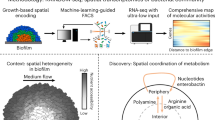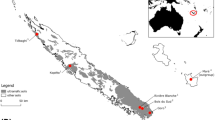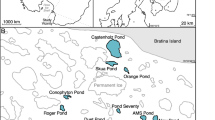Abstract
To appreciate the functional diversity of communities of soil eukaryotic micro-organisms we evaluated an experimental approach based on the construction and screening of a cDNA library using polyadenylated mRNA extracted from a forest soil. Such a library contains genes that are expressed by each of the different organisms forming the community and represents its metatranscriptome. The diversity of the organisms that contributed to this library was evaluated by sequencing a portion of the 18S rDNA gene amplified from either soil DNA or reverse-transcribed RNA. More than 70% of the sequences were from fungi and unicellular eukaryotes (protists) while the other most represented group was the metazoa. Calculation of richness estimators suggested that more than 180 species could be present in the soil samples studied. Sequencing of 119 cDNA identified genes with no homologues in databases (32%) and genes coding proteins involved in different biochemical and cellular processes. Surprisingly, the taxonomic distribution of the cDNA and of the 18S rDNA genes did not coincide, with a marked under-representation of the protists among the cDNA. Specific genes from such an environmental cDNA library could be isolated by expression in a heterologous microbial host, Saccharomyces cerevisiae. This is illustrated by the functional complementation of a histidine auxotrophic yeast mutant by two cDNA originating possibly from an ascomycete and a basidiomycete fungal species. Study of the metatranscriptome has the potential to uncover adaptations of whole microbial communities to local environmental conditions. It also gives access to an abundant source of genes of biotechnological interest.
Similar content being viewed by others
Log in or create a free account to read this content
Gain free access to this article, as well as selected content from this journal and more on nature.com
or
References
Altshul SF, Madden TL, Schaffer AA, Zhang JH, Zhang Z, Miller W et al. (1997). Gapped BLAST and PSI-BLAST: a new generation of protein database search programs. Nucl Acids Res 25: 3389–3402.
Aury J-M, Jaillon O, Duret L, Noel B, Jubin C, Porcer BM et al. (2006). Global trends of whole-genome duplications revealed by the ciliate Paramecium tetraurelia. Nature 444: 171–178.
Borneman J, Hartin RJ . (2000). PCR primers that amplify fungal rRNA genes from environmental samples. Appl Environ Microbiol 66: 4356–4360.
Courtois S, Cappellano CM, Ball M, Francou FX, Normand P, Helynck G et al. (2003). Recombinant environmental libraries provide access to microbial diversity for drug discovery from natural products. Appl Environ Microbiol 69: 49–55.
Delong EF, Preston CM, Mincer T, Rich V, Hallam SJ, Frigaard NU et al. (2006). Community genomics among stratified microbial assemblages in the ocean's interior. Science 311: 496–503.
Diez B, Pedros-Alio C, Massana R . (2001). Study of genetic diversity of eukaryotic picoplankton in different oceanic regions by small-subunit rRNA gene cloning and sequencing. Appl Environ Microbiol 67: 2932–2941.
Ekelund F, Rønn R, Christensen S . (2001). Distribution with depth of protozoa, bacteria, and fungi in soil profiles from three Danish forest sites. Soil Biol Biochem 33: 475–481.
Galtier N, Gouy M, Gautier C . (1996). SeaView and Phylo_win, two graphic tools for sequence alignment and molecular phylogeny. Comput Applic Biosci 12: 543–548.
García Martín H, Ivanova N, Kunin V, Warnecke F, Barry KW, MacHardy AC et al. (2006). Metagenomic analysis of two enhanced biological phosphorus removal (EBPR) sludge communities. Nat Biotechnol 24: 1263–1269.
Gillespie DE, Brady SF, Bettermann AD, Cianciotto NP, Liles MR, Rondon MR et al. (2002). Isolation of antibiotics turbomycin A and B from a metagenomic library of soil microbial DNA. Appl Environ Microbiol 68: 4301–4306.
Grant S, Grant WD, Cowan DA, Jones BE, Ma Y, Ventosa A et al. (2006). Identification of eukaryotic open reading frames in metagenomic cDNA libraries made from environmental samples. Appl Environ Microbiol 72: 135–143.
Gryta H, Debaud JC, Effosse A, Gay G, Marmeisse R . (1997). Fine-scale structure of populations of the ectomycorrhizal fungus Hebeloma cylindrosporum in coastal sand dune forest ecosystems. Mol Ecol 6: 353–364.
Guidot A, Debaud JC, Marmeisse R . (2001). Correspondence between genet diversity and spatial distribution of above- and below-ground populations of the ectomycorrhizal fungus Hebeloma cylindrosporum. Mol Ecol 10: 1121–1131.
Högberg MN, Högberg P . (2002). Extramatrical ectomycorrhizal mycelium contributes one third of microbial biomass and produces, together with associated roots, half of the dissolved organic carbon in a forest soil. New Phytol 154: 791–795.
Horton TR, Bruns TD . (2001). The molecular revolution in ectomycorrhizal ecology: peeking into the black-box. Mol Ecol 10: 1855–1871.
Keller NP, Hohn TM . (1997). Metabolic pathway gene clusters in filamentous fungi. Fung Genet Biol 21: 17–29.
Kemp PF, Aller JY . (2004). Estimating prokaryotic diversity: when are 16S rDNA libraries large enough? Limnol Oceanogr Methods 2: 114–125.
Lilleskov EA, Bruns TD, Horton TR, Taylor DL, Grogan P . (2004). Detection of forest stand-level spatial structure in ectomycorrhizal fungal communities. FEMS Microbiol Ecol 49: 319–332.
Moreira D, von der Heyden S, Bass D, López-García P, Chao E, Cavalier-Smith T . (2007). Global eukaryote phylogeny: combined small- and large-subunit ribosomal DNA trees support monophyly of Rhizaria, Retaria and Excavata. Mol Phylogenet Evol 44: 255–266.
Nesbø CL, Boucher Y, Dlutek M, Doolittle WF . (2005). Lateral gene transfer and phylogeneyic assignment of environmental fosmid clones. Environ Microbiol 7: 2011–2026.
O'Brien HE, Parrent JL, Jackson JA, Montcalvo J-M, Vilgalys R . (2005). Fungal community analysis by large-scale sequencing of environmental samples. Appl Environ Microbiol 71: 5544–5550.
Rappe MS, Giovannoni SJ . (2003). The uncultured microbial majority. Ann Rev Microbiol 57: 369–394.
Rondon MR, August PR, Bettermann AD, Brady SF, Grossman TH, Liles MR et al. (2000). Cloning the soil metagenome: a strategy for accessing the genetic and functional diversity of uncultured microorganisms. Appl Environ Microbiol 66: 2541–2547.
Rose MD, Winston F, Hieter P . (1990). Methods in Yeast Genetics: A Laboratory Course Manual. Cold Spring Harbor Press: Cold Spring Harbor, NY.
Rusch DB, Halpern AL, Sutton G, Heidelberg KB, Williamson S, Yooseph S et al. (2007). The sorcerer II global sampling expedition: northwest atlantic through eastern tropical pacific. PloS Biol 5: e77.
Schirmer A, Gadkari R, Reeves CD, Ibrahim F, DeLong EF, Hutchinson CR . (2005). Metagenomic analysis reveals diverse polyketide synthase gene clusters in microorganisms associated with the marine sponge Discodermia dissoluta. Appl Environ Microbiol 71: 4840–4849.
Simpson AGB, Roger AJ . (2004). The real ‘kingdoms’ of eukaryotes. Curr Biol 44: R693–R696.
Strous M, Pelletier E, Mangenot S, Rattei T, Lehner A, Taylor MW et al. (2006). Deciphering the evolution and metabolism of an anamox bacterium from a community genome. Nature 440: 790–794.
Thompson JD, Higgins DG, Gibson TJ . (1994). CLUSTAL W: improving the sensivity of progressive multiple sequence alignment through sequence weighting, position-specific gap penalties and weight matrix choice. Nucl Acids Res 22: 4673–4680.
Todaka N, Moriya S, Saita K, Hondo T, Kiuchi I, Takasu H et al. (2007). Environmental cDNA analysis of the genes involved in lignocellulose digestion in the symbiotic protist community of Reticulitermes speratus. FEMS Microbiol Ecol 59: 592–599.
Tringe S, von Mering C, Kobayashi A, Salamov AA, Chen K, Chang HW et al. (2005). Comparative metagenomics of microbial communities. Science 308: 554–557.
Tyson GW, Chapman J, Hugenholtz P, Allen EE, Ram RJ, Richardson PM et al. (2004). Community structure and metabolism through reconstruction of microbial genomes from the environment. Nature 428: 37–43.
Venter JC, Remington K, Heidelberg JF, Halpern AL, Rusch D, Eisen JA et al. (2004). Environmental genome shotgun sequencing of the Sargasso Sea. Science 304: 66–74.
Voget S, Leggewie C, Uesbeck A, Raasch C, Jaeger KE, Streit WR . (2003). Prospecting for novel biocatalysts in a soil metagenome. Appl Environ Microbiol 69: 6235–6242.
Wood V, Gwilliam R, Rajandream M-A, Lyne M, Lyne R, Stewart A et al. (2002). The genome sequence of Schizosaccharomyces pombe. Nature 415: 871–880.
Yooseph S, Sutton G, Rusch DB, Halpern AL, Williamson SJ, Remington K et al. (2007). The Sorcerer II global ocean sampling expedition: expanding the universe of protein families. PLoS Biol 5: e16.
Yun J, Kang S, Park S, Yoon H, Kim MJ, Hew S et al. (2004). Characterization of a novel amylolytic enzyme encoded by a gene from a soil derived metagenomic library. Appl Environ Microbiol 70: 7229–7235.
Acknowledgements
This work was supported by grants from the University Lyon 1 (BQR 2005), the French Ministry of Ecology and Sustainable Development (PNETOX programme) and the IFR 41. Sequencing of ribosomal genes was supported by an ‘Etude et Appuis’ grant of the Bureau des Ressources Génétiques. We thank Jacques Guinberteau and the other members of the INRA of Bordeaux for their help in field work and the determination of fungal species and the DTAMB of the University Lyon 1 for the use of the Agilent Bioanalyzer.
Author information
Authors and Affiliations
Corresponding author
Additional information
Supplementary Information accompanies the paper on The ISME Journal website (http://www.nature.com/ismej)
Supplementary information
Rights and permissions
About this article
Cite this article
Bailly, J., Fraissinet-Tachet, L., Verner, MC. et al. Soil eukaryotic functional diversity, a metatranscriptomic approach. ISME J 1, 632–642 (2007). https://doi.org/10.1038/ismej.2007.68
Received:
Revised:
Accepted:
Published:
Issue date:
DOI: https://doi.org/10.1038/ismej.2007.68
Keywords
This article is cited by
-
Expanding the range of the respiratory infectome in Australian feedlot cattle with and without respiratory disease using metatranscriptomics
Microbiome (2023)
-
Metagenomics and metatranscriptomics as potential driving forces for the exploration of diversity and functions of micro-eukaryotes in soil
3 Biotech (2023)
-
Metatranscriptomic insight into the possible role of clay microbiome in skin disease management
International Journal of Biometeorology (2023)
-
Metagenomic analysis of heavy metal-contaminated soils reveals distinct clades with adaptive features
International Journal of Environmental Science and Technology (2023)
-
Protection from metal toxicity by Hsp40-like protein isolated from contaminated soil using functional metagenomic approach
Environmental Science and Pollution Research (2021)



